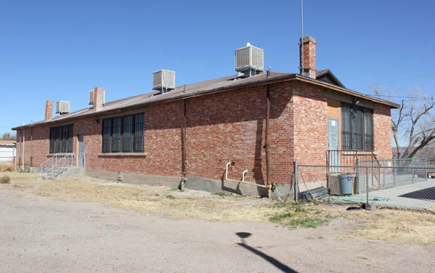 A segregated New Mexico grade school built during the Jim Crow years was listed in the National Register of Historic Places during Black History Month, the New Mexico Historic Preservation Division announced today.
A segregated New Mexico grade school built during the Jim Crow years was listed in the National Register of Historic Places during Black History Month, the New Mexico Historic Preservation Division announced today.
The Paul Laurence Dunbar Elementary School in Vado near the Mexico border was built in 1926, the same year the precursor of Black History Month was established as the second week of February in recognition of Abraham Lincoln’s birthday. The school in Vado was built during a period when white residents of Southern states — especially Texas — began moving to New Mexico, which subsequently adopted Jim Crow laws in 1925, nearly 50 years after they were established to segregate all public facilities in former Confederate states.
Most African American students in the South attended substandard, poorly built and over-crowded schools because of the laws. This was not the case in most of New Mexico’s segregated communities.
“Segregated schools in New Mexico built for African American Children were often solidly built, as indicated by the brick-and-concrete Dunbar School,” said Steven Moffson, HPD State and National Register coordinator. “In fact, state legislation from 1925 required classrooms and schools built for children of African descent be ‘as good and well-kept as those used by pupils of Caucasian or other descent’.”
Segregation in New Mexico ended shortly after the 1954 Brown v. Board of Education decision, years before it was abolished nationally as part of the Civil Rights Act of 1964 and the Voting Rights Act of 1965. Most southern states did not desegregate their schools until 1970.
Bobbie J. Boyer attended the school from 1945–1954. She remembers the four-room school which held two grades in each classroom for its “outstanding teachers and the principal, Gile B. Grimes,” and the good, basic education she and other students received. Commemorating the school as a local landmark was the dream of her late husband, Roosevelt, and the Boyer family, which first came to New Mexico c. 1901 when Frank Boyer founded the short-lived agricultural community Blackdom north of Artesia.
“So many black people came to New Mexico from southern states for a better life,” she said. “It is important to remember this school and that Vado was an all-black community when it was settled because not everything that happened to black people in history happened in the South.”
Bobbie Boyer and the president of the Vado Historical Society, Johnny Holguin and his wife, Esty, actively pursued the nomination. Holguin graduated from the school in 1957, the final year schools were segregated in New Mexico. The school continues to be the community’s focal point, is used for many gatherings, and houses a local Head Start program. It also is the sole surviving public building in Vado.
“The Dunbar school is a landmark in the history of segregation and in the history of African Americans in New Mexico,” said Jeff Pappas, State Historic Preservation officer and HPD director. “We’re grateful to have had the opportunity to list this school in the State and National Register, not only for its important place in the state history but because it opens the door for other underrepresented communities to come forward with important buildings and other cultural resources to be recognized in the Registers.”
The Dunbar School is among six surviving schools built during segregation, primarily in southern and eastern parts of the state. Alamogordo, Artesia, Carlsbad, Clovis, Hobbs, Las Cruces, Roswell, and Tucumcari also had segregated schools.
During Heritage Preservation Month in May, HPD and communities around the state will honor historic preservation achievements and identify future preservation initiatives. Achievements also will be recognized with awards presented by the State Cultural Properties Review Committee, which first listed the Dunbar School to the State Register in December.
The 2017 Preservation Month theme, Untold Stories: Cultural Diversity in New Mexico, will be interpreted on the 30th annual Preservation Month poster and in some of the 40 preservation month events that will be held statewide in May.


